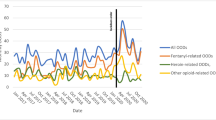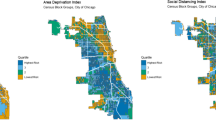Abstract
Opioid misuse is a significant public health issue and a national epidemic with a high prevalence of associated morbidity and mortality. The epidemic is particularly severe in Ohio which has some of the highest overdose rates in the country. It is important to understand spatial and temporal trends of the opioid epidemic to learn more about areas that are most affected and to inform potential community interventions and resource allocation. We propose a multivariate spatio-temporal model to leverage existing surveillance measures, opioid-associated deaths and treatment admissions, to learn about the underlying epidemic for counties in Ohio. We do this using a temporally varying spatial factor that synthesizes information from both counts to estimate common underlying risk which we interpret as the burden of the epidemic. We demonstrate the use of this model with county-level data from 2007 to 2018 in Ohio. Through our model estimates, we identify counties with above and below average burden and examine how those regions have shifted over time given overall statewide trends. Specifically, we highlight the sustained above average burden of the opioid epidemic on southern Ohio throughout the 12 years examined.




Similar content being viewed by others
Availability of data and material
The overdose death datasets analyzed during the current study are available in the Ohio Public Health Data Warehouse, http://publicapps.odh.ohio.gov/EDW/DataCatalog. The treatment admissions data that support the findings of this study are available from the Ohio Department of Mental Health and Addiction Services but restrictions apply to the availability of these data, which were used under a data use agreement, and so are not publicly available. Data are however available from the authors upon reasonable request and with permission of the Ohio Department of Mental Health and Addiction Services.
Code availability
Code has been provided as Electronic Supplementary Material.
References
Banerjee, S., Carlin, B.P., Gelfand, A.E.: Hierarchical Modeling and Analysis for Spatial Data. Chapman & Hall/CRC, Boca Raton (2004)
Besag, J.: Spatial interaction and the statistical analysis of lattice systems. J. R. Stat. Soc. Ser. B (Methodol.) 36(2), 192–236 (1974)
Centers for Disease Control and Prevention: National survey on drug use and health, 2013 and 2014 (2019). Internet https://www.cdc.gov/opioids/index.html
Daniulaityte, R., Juhascik, M.P., Strayer, K.E., Sizemore, I.E., Harshbarger, K.E., Antonides, H.M., Carlson, R.R.: Overdose deaths related to fentanyl and its analogs—Ohio, January–February 2017. MMWR Morb. Mortal. Wkly. Rep. 66(34), 904–908 (2017)
de Valpine, P., Turek, D., Paciorek, C., Anderson-Bergman, C., Temple Lang, D., Bodik, R.: Programming with models: writing statistical algorithms for general model structures with NIMBLE. J. Comput. Graph. Stat. 26, 403–417 (2017). https://doi.org/10.1080/10618600.2016.1172487
Division of Unintentional Injury Prevention: Drug overdose data (2017). Internet, https://www.cdc.gov/drugoverdose/data/statedeaths.html
Drug Enforcement Agency: 2016 National drug threat assessment (2016). Internet, https://www.dea.gov/resource-center/2016%20NDTA%20Summary.pdf
Famoye, F., Wang, W.: Censored generalized Poisson regression model. Comput. Stat. Data Anal. 46(3), 547–560 (2004)
Governor’s Cabinet Opiate Action Team: Combating the opiate crisis in Ohio (2018). Online; https://mha.ohio.gov/Portals/0/assets/ResearchersAndMedia/Combating%20Opiate%20Abuse/Combating-the-Opiate-Crisis_SEPT-2018.pdf?ver=2018-11-29-113014-833. Accessed 25 Feb 2020
Hepler, S., Bonny, A., McKnight, E., Kline, D.: A latent spatial factor approach for synthesizing opioid associated deaths and treatment admissions in Ohio counties. Epidemiology 30(3), 365–370 (2019)
Neeley, E., Christensen, W., Sain, S.: A Bayesian spatial factor analysis approach for combining climate model ensembles. Environmetrics 25(7), 483–497 (2014). https://doi.org/10.1002/env.2277
Ohio Department of Health, Bureau of Vital Statistics: Odh violence and injury prevention program (2019). Online; https://odh.ohio.gov/wps/wcm/connect/gov/5deb684e-4667-4836-862b-cb5eb59acbd3/2017_OhioDrugOverdoseReport.pdf. Accessed 5 Nov 2019
Palamar, J.J., Shearston, J.A., Cleland, C.M.: Discordant reporting of nonmedical opioid use in a nationally representative sample of US high school seniors. Am. J. Drug Alcohol Abuse 42(5), 530–538 (2016)
Pianntadosi, S., Byar, D.P., Green, S.B.: The ecological fallacy. Am. J. Epidemiol. 127(5), 893–904 (1988). https://doi.org/10.1093/oxfordjournals.aje.a114892
Rudd, R., Seth, P., David, F., Scholl, L.: Increases in drug and opioid-involved overdose deaths–United States, 2010–2015. MMWR Morb. Mortal. Wkly. Rep. 65, 1445–1452 (2016a)
Rudd, R.A., Aleshire, N., Zibbell, J.E., Gladden, R.M.: Increases in drug and opioid overdose deaths-United States, 2000–2014. MMWR Morb. Mortal. Wkly. Rep. 64(50–51), 50–51 (2016b)
SAMHSA: Key substance use and mental health indicators in the United States: results from the 2018 national survey on drug use and health. HHS Publication No. PEP19-5068, NSDUH Series H-54 (2019). http://www.samhsa.gov/
Scholl, L., Seth, P., Kariisa, M., Wilson, N., Baldwin, G.: Drug and opioid-involved overdose deaths—United States, 2013–2017. MMWR 67, 1419–1427 (2019)
Slavova, S., O’Brien, D.B., Creppage, K., Dao, D., Fondario, A., Haile, E., Hume, B., Largo, T.W., Nguyen, C., Sabel, J.C., Wright, D., Members of the Council of State and Territorial Epidemiologists Overdose Subcommittee: Drug overdose deaths: let’s get specific. Public Health Rep. 130(4), 339–342 (2015)
Wall, M.M., Wang, F.: Generalized common spatial factor model. Biostatistics 4(4), 569–582 (2003)
Zibbell, J., Igbal, K., Patel, R., Suryaprasad, A., Sanders, K., Moore-Moravian, L., Serrecchia, J., Blankenship, S., Ward, J., Holtzman, D., Centers for Disease Control and Prevention: Increases in hepatitis c virus infection related to injection drug use among persons aged \(\ge \) 30 years–Kentucky, Tennessee, Virginia, and West Virginia, 2006–2012. MMWR 64(17), 453–458 (2015)
Acknowledgements
Research reported in this publication was supported by the National Institute On Drug Abuse of the National Institutes of Health under Award Number R21DA045236. The content is solely the responsibility of the authors and does not necessarily represent the official views of the National Institutes of Health. These data were provided by the Ohio Department of Health. The Department specifically disclaims responsibility for any analyses, interpretations or conclusions.
Author information
Authors and Affiliations
Corresponding author
Ethics declarations
Conflict of interest
The authors declare that they have no conflict of interest.
Additional information
Publisher's Note
Springer Nature remains neutral with regard to jurisdictional claims in published maps and institutional affiliations.
Electronic supplementary material
Below is the link to the electronic supplementary material.
Rights and permissions
About this article
Cite this article
Kline, D., Ji, Y. & Hepler, S. A multivariate spatio-temporal model of the opioid epidemic in Ohio: a factor model approach. Health Serv Outcomes Res Method 21, 42–53 (2021). https://doi.org/10.1007/s10742-020-00227-3
Received:
Revised:
Accepted:
Published:
Issue Date:
DOI: https://doi.org/10.1007/s10742-020-00227-3




